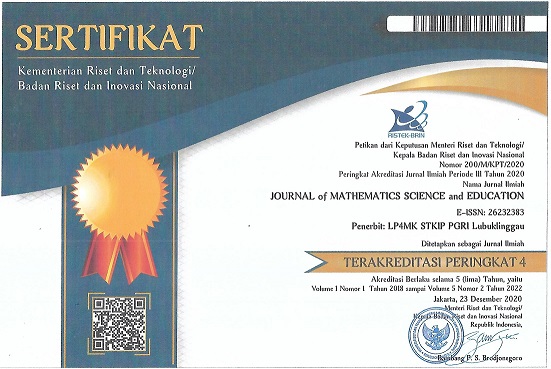KEMAMPUAN BERPIKIR KRITIS SISWA BERBASIS MODEL MISSOURI MATHEMATICS PROJECT MENGGUNAKAN STRATEGI THINK TALK WRITE
Abstract
This research aims to describe the critical thinking skills of students using the Missouri Mathematics Project learning model combined with Think Talk Write strategies on cube and block material. This research was conducted at Xaverius Junior High School Lubuklinggau grade VIII of the 2016/2017 academic year in the even semester. Before carrying out the research, the test questions were first tested to see validity, reliability, differentiation and the level of difficulty of the questions. Of the 5 questions tested, all the questions are valid with a moderate reliable level. The learning process uses the Missouri Mathematics Project learning model combined with the Think Talk Write strategy. The data collection technique uses a test of 5 questions which refers to the indicators of students' critical thinking abilities. Based on the results of the study, the results of students' critical thinking skills in the cube and block material grade VIII of Xaverius Junior High School Lubuklinggau in the academic year 2016/2017 with an average score of 89.53 included in the excellent category. The percentage of each indicator can be seen that: the indicator interprets as much as 69.44%, the analyzing indicator gets a percentage of 92.59% in the very good category. The evaluation indicator shows that the percentage of 99.07% is in the very good category. In the last indicator, which is input, the percentage of 96.53% is in the excellent category.
References
Fithriyah, I., Sa'dijah, C., & Sisworo. (2016). Analisis Kemampuan Berpikir Kritis Siswa Kelas IX-D SMPN 17 Malang. Konferensi Nasional Penelitian Pendidikan Matematika dan Pembelajarannya (KNPMP I) (hal. 580-590). Surakarta: Universitas Muhammadyah Surakarta.
Hasanah, Umi. (2012). Efektifitas Strategi Pembelajaran Tipe TTW terhadap Pemahaman Konsep Matematis Siswa. Lampung : Unila
Ismaimuza, D. (2011). Kemampuan Berpikir Kritis Matematis ditinjau dari Pengetahuan Awal Siswa. Jurnal Pendidikan Matematika, 2(1), 11-20.
Jumaisyaroh, T., Napitupulu, E. E., & Hasratuddin. (2014). Peningkatan Kemampuan Berpikir Kritis Matematis dan Kemandirian Belajar Siswa SMP melalui Pembelajaran Berbasis Masalah. Jurnal Kreano, 5(2), 157-169.
Karim, & Normaya. (2015). Kemampuan Berpikir Kritis Siswa dalam Pembelajaran Matematika dengan Menggunakan Model Jucama di Sekolah Menengah Pertama. EDU-MAT Jurnal Pendidikan Matematika, 3(1), 92-104.
Mulyono, D., Purwasi, L., & Riyadi, A. (2018). Penerapan Metode Penemuan Terbimbing pada Pembelajaran Matematika Siswa SMP. Journal of Education and Instruction (JOEAI), 1(1), 51-58. https://doi.org/10.31539/joeai.v1i1.240.
Sutarman, Mardiyana, & Triyanto. (2014). Eksperimentasi Pembelajaran Matematika dengan Model Think Talk Write (TTW) dan Missouri Mathematics Project (MMP) ditinjau dari Gaya Belajar Siswa Kelas VII SMP Negeri di Kabupaten Pacitan Tahun Ajaran 2012/2013. Jurnal Elektronik Pembelajaran Matematika, 2(10), 1008-1030.
Wahyuni, R., & Efuansyah. (2018). Model Pembelajaran Missouri Mathematics Project (MMP) Menggunakan Strategi Think Talk Write (TTW) terhadap Kemampuan Berpikir Kritis dan Kemampuan Pemecahan Masalah. Jurnal Nasional Pendidikan Matematika, 2(1), 24-36.
Yamin & Basun. (2009). Taktik Mengembangkan Kemampuan Individual Siswa. Jakarta : Gaung Persada Press

This work is licensed under a Creative Commons Attribution 4.0 International License.

This work by Journal of Mathematics Science and Education is licensed under a Creative Commons Attribution-NonCommercial-ShareAlike 4.0 International License.



















